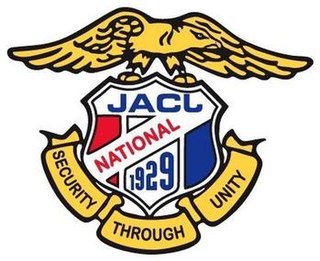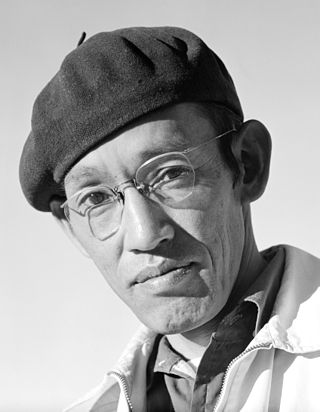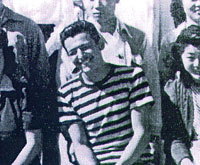Related Research Articles

Manzanar is the site of one of ten American concentration camps, where more than 120,000 Japanese Americans were incarcerated during World War II from March 1942 to November 1945. Although it had over 10,000 inmates at its peak, it was one of the smaller internment camps. The largest was the Tule Lake internment camp, located in northern California with a population of over 18,000 inmates. The smallest was Amanche, located southeastern Colorado, with over 7,000 inmates. It is located at the foot of the Sierra Nevada mountains in California's Owens Valley, between the towns of Lone Pine to the south and Independence to the north, approximately 230 miles (370 km) north of Los Angeles. Manzanar means "apple orchard" in Spanish. The Manzanar National Historic Site, which preserves and interprets the legacy of Japanese American incarceration in the United States, was identified by the United States National Park Service as the best-preserved of the ten former camp sites.

During World War II, the United States forcibly relocated and incarcerated at least 125,284 people of Japanese descent in 75 identified incarceration sites. Most lived on the Pacific Coast, in concentration camps in the western interior of the country. Approximately two-thirds of the inmates were United States citizens. These actions were initiated by president Franklin D. Roosevelt via an executive order shortly after Imperial Japan's attack on Pearl Harbor.

The Civil Liberties Act of 1988 is a United States federal law that granted reparations to Japanese Americans who had been wrongly interned by the United States government during World War II and to "discourage the occurrence of similar injustices and violations of civil liberties in the future". The act was sponsored by California Democratic congressman and former internee Norman Mineta, Wyoming Republican senator Alan K. Simpson and California senator Pete Wilson. The bill was supported by the majority of Democrats in Congress, while the majority of Republicans voted against it. The act was signed into law by President Ronald Reagan.

The Japanese American Citizens League is an Asian American civil rights charity, headquartered in San Francisco, with regional chapters across the United States.

Tōyō Miyatake was a Japanese American photographer, best known for his photographs documenting the Japanese American people and the Japanese American internment at Manzanar during World War II.

Jeanne Wakatsuki Houston is an American writer. Her writings primarily focus on ethnic identity formation in the United States of America. She is best known for her autobiographical novel Farewell to Manzanar that narrates her personal experiences in World War II internment camps.
The Commission on Wartime Relocation and Internment of Civilians (CWRIC) was a group of nine people appointed by the U.S. Congress in 1980 to conduct an official governmental study into the internment of Japanese Americans during World War II.
On February 19, 1942, shortly after Japan's surprise attack on Pearl Harbor in Hawaii, President Franklin D. Roosevelt signed Executive Order 9066 authorizing the forced removal of over 110,000 Japanese Americans from the West Coast and into internment camps for the duration of the war. The personal rights, liberties, and freedoms of Japanese Americans were suspended by the United States government. In the "relocation centers", internees were housed in tar-papered army-style barracks. Some individuals who protested their treatment were sent to a special camp at Tule Lake, California.
The following article focuses on the movement to obtain redress for the internment of Japanese Americans during World War II, and significant court cases that have shaped civil and human rights for Japanese Americans and other minorities. These cases have been the cause and/or catalyst to many changes in United States law. But mainly, they have resulted in adjusting the perception of Asian immigrants in the eyes of the American government.
Togo W. Tanaka was an American newspaper journalist and editor who reported on the difficult conditions in the Manzanar camp, where he was one of 110,000 Japanese Americans who had been relocated after the Japanese attack on Pearl Harbor on December 7, 1941.
William Minoru Hohri was an American political activist and the lead plaintiff in the National Council for Japanese American Redress lawsuit seeking monetary reparations for the internment of Japanese Americans during World War II. He was sent to the Manzanar concentration camp with his family after the attack on Pearl Harbor triggered the United States' entry into the war. After leading the NCJAR's class action suit against the federal government, which was dismissed, Hohri's advocacy helped convince Congress to pass legislation that provided compensation to each surviving internee. The legislation, signed by President Ronald Reagan in 1988, included an apology to those sent to the camps.
Edison Tomimaro Uno (1929–1976) was a Japanese American civil rights advocate, best known for opposing laws used to implement the mass detention of Japanese Americans during World War II and for his role in the early stages of the movement for redress after the war. To many Japanese American activists, Uno was the father of the redress movement.
James Yutaka Matsumoto Omura was the English language editor of the Rocky Shimpo newspaper in Denver, Colorado, during World War II. He was an outspoken critic of the expulsion of people of Japanese ancestry from the west coast of the United States to concentration camps, following the Japanese attack on Pearl Harbor. Subsequently, he became a vocal champion of the Nisei draft resisters, providing a 'substantial anchor' to the work of the Heart Mountain Fair Play Committee by publishing their grievances in the Rocky Shimpo. At a time when the Japanese American Citizens League (JACL) preached passive conformity with the federal government as the best policy, Omura became the JACL's arch-enemy for counseling active resistance.
Aiko Herzig-Yoshinaga was a Japanese American political activist who played a major role in the Japanese American redress movement. She was the lead researcher of the Commission on Wartime Relocation and Internment of Civilians (CWRIC), a bipartisan federal committee appointed by Congress in 1980 to review the causes and effects of the Japanese American incarceration during World War II. As a young woman, Herzig-Yoshinaga was confined in the Manzanar Concentration Camp in California, the Jerome War Relocation Center in Arkansas, and the Rohwer War Relocation Center, which is also in Arkansas. She later uncovered government documents that debunked the wartime administration's claims of "military necessity" and helped compile the CWRIC's final report, Personal Justice Denied, which led to the issuance of a formal apology and reparations for former camp inmates. She also contributed pivotal evidence and testimony to the Hirabayashi, Korematsu and Yasui coram nobis cases.

Ralph Lazo was the only known non-spouse, non-Japanese American who voluntarily relocated to a World War II Japanese American internment camp. His experience was the subject of the 2004 narrative short film Stand Up for Justice: The Ralph Lazo Story.

Takayo "Rose" Matsui Ochi was a Japanese-American attorney and civil rights activist notable for fighting for the approval of the Manzanar to become a National Historic Site and being the first Asian American woman to be appointed at the United States Assistant Attorney General level by President Bill Clinton, as well as being the first Asian American to be appointed to the Los Angeles Police Commission.
John Tateishi is the former redress director of the Japanese American Citizens League and was a key figure in the campaign for reparations for the Internment of Japanese Americans.
Frank Fumio Chuman is a Japanese-American former civil rights attorney and author, involved in several important Japanese American civil rights cases and in the redress movement.
References
- 1 2 Ralph Lazo – A True Friend Archived 2007-04-16 at the Wayback Machine
- ↑ Stand Up for Justice: The Story of Ralph Lazo
- ↑ Memories of Manzanar.”For some people, « Guavalog: “They said this day would never come.”
- ↑ Reading: The Incarceration Years Archived 2009-10-02 at the Wayback Machine
- ↑ "Stand Up for Justice:The Ralph Lazo Story". National Coalition for Civil Rights and Redress. January 2004. Retrieved April 23, 2007.
- ↑ California State Library – CCLPEP Advisory Committee